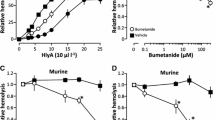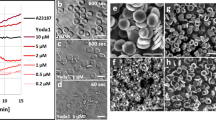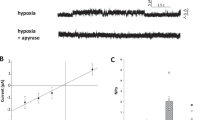Abstract
α-Hemolysin (HlyA) from Escherichia coli lyses mammalian erythrocytes by creating nonselective cation pores in the membrane. Pore insertion triggers ATP release and subsequent P2X receptor and pannexin channel activation. Blockage of either P2X receptors or pannexin channels reduces HlyA-induced hemolysis. We found that erythrocytes from Python regius and Python molurus are remarkably resistant to HlyA-induced hemolysis compared to human and Trachemys scripta erythrocytes. HlyA concentrations that induced maximal hemolysis of human erythrocytes did not affect python erythrocytes, but increasing the HlyA concentration 40-fold did induce hemolysis. Python erythrocytes were more resistant to osmotic stress than human erythrocytes, but osmotic stress tolerance per se did not confer HlyA resistance. Erythrocytes from T. scripta, which showed higher osmotic resistance than python erythrocytes, were as susceptible to HlyA as human erythrocytes. Therefore, we tested whether python erythrocytes lack the purinergic signalling known to amplify HlyA-induced hemolysis in human erythrocytes. P. regius erythrocytes increased intracellular Ca2+ concentration and reduced cell volume when exposed to 3 mM ATP, indicating the presence of a P2X7-like receptor. In addition, scavenging extracellular ATP or blocking P2 receptors or pannexin channels reduced the HlyA-induced hemolysis. We tested whether the low HlyA sensitivity resulted from low affinity of HlyA to the python erythrocyte membrane. We found comparable incorporation of HlyA into human and python erythrocyte membranes. Taken together, the remarkable HlyA resistance of python erythrocytes was not explained by increased osmotic resistance, lack of purinergic hemolysis amplification, or differences in HlyA affinity.







Similar content being viewed by others
References
Aldrich K, Saunders DK (2001) Comparison of erythrocyte osmotic fragility among ectotherms and endotherms at three temperatures. J Thermal Biol 26:179–182
Beraldo FH, Garcia CR (2007) Divergent calcium signaling in RBCs from Tropidurus torquatus (Squamata, Tropiduridae) strengthen classification in lizard evolution. BMC Physiol 7:7
Beraldo FH, Sartorello R, Gazarini ML, Caldeira W, Garcia CR (2002) Red blood cells of the lizards Ameiva ameiva (Squamata, Teiidae) display multiple mechanisms to control cytosolic calcium. Cell Calcium 31:79–87
Bhakdi S, Mackman N, Nicaud JM, Holland IB (1986) Escherichia coli hemolysin may damage target-cell membranes by generating transmembrane pores. Infect Immun 52:63–69
Bhakdi S, Mackman N, Menestrina G, Gray L, Hugo F, Seeger W, Holland IB (1988) The hemolysin of Escherichia coli. Eur J Epidemiol 4:135–143
Cassidy PS, Harshman S (1973) The binding of staphylococcal 125I-alpha-toxin (B) to erythrocytes. J Biol Chem 248:5545–5546
Cavalieri SJ, Bohach GA, Snyder IS (1984) Escherichia coli α-hemolysin—characteristics and probable role in pathogenicity. Microbiol Rev 48:326–343
Cohen WD (1991) The cytoskeletal system of nucleated erythrocytes. Int J Cytol 130:37–84
Conly JM, Stein K (1992) Quantitative and qualitative measurements of vitamin-K in human intestinal contents. Am J Gastroenterol 87:311–316
Cortajarena AL, Goni FM, Ostolaza H (2001) Glycophorin as a receptor for Escherichia coli alpha-hemolysin in erythrocytes. J Biol Chem 276:12513–12519
Cortajarena AL, Goni FM, Ostolaza H (2003) A receptor-binding region in Escherichia coli α-haemolysin. J Biol Chem 278:19159–19163
Costa-Junior HM, Mendes AN, Davis GHNG, da Cruza CM, Ventura ALM, Serezani CH, Faccioli LH, Nomizo A, Freire-De-Lima CG, Bisaggio RD, Persechini PM (2009) ATP-induced apoptosis involves a Ca2+-independent phospholipase A2 and 5-lipoxygenase in macrophages. Prostaglandins Other Lipid Mediat 88:51–61
Felmlee T, Pellett S, Welch RA (1985) Nucleotide-sequence of an Escherichia coli chromosomal hemolysin. J Bacteriol 163:94–105
Gadeberg OV, Orskov I, Rhodes JM (1983) Cyto-toxic effect of an alpha-hemolytic Escherichia coli strain on human-blood monocytes and granulocytes invitro. Infect Immun 41:358–364
Gasbjerg PK, Brahm J (1991) Kinetics of bicarbonate and chloride transport in human red-cell membranes. J Gen Physiol 97:321–349
Hudault S, Guignot J, Servin AL (2001) Escherichia coli strains colonising the gastrointestinal tract protect germfree mice against Salmonella typhimurium infection. Gut 49:47–55
Husmann M, Beckmann E, Boller K, Kloft N, Tenzer S, Bobkiewicz W, Neukirch C, Bayley H, Bhakdi S (2009) Elimination of a bacterial pore-forming toxin by sequential endocytosis and exocytosis. FEBS Lett 583:337–344
Hyland C, Vuillard L, Hughes C, Koronakis V (2001) Membrane interaction of Escherichia coli hemolysin: flotation and insertion-dependent labeling by phospholipid vesicles. J Bacteriol 183:5364–5370
Johnson JR, Stell AL (2000) Extended virulence genotypes of Escherichia coli strains from patients with urosepsis in relation to phylogeny and host compromise. J Infect Dis 181:261–272
Jorgensen SE, Hammer RF, Wu GK (1980) Effects of a single hit from the alpha hemolysin produced by Escherichia coli on the morphology of sheep erythrocytes. Infect Immun 27:988–994
Joseph-Silverstein J, Cohen WD (1984) The cytoskeletal system of nucleated erythrocytes. 3. Marginal band function in mature cells. J Cell Biol 98:2118–2125
Koschinski A, Repp H, Unver B, Dreyer F, Brockmeier D, Valeva A, Bhakdi S, Walev I (2006) Why Escherichia coli alpha-hemolysin induces calcium oscillations in mammalian cells—the pore is on its own. FASEB J 20:973–975
Le Stunff H, Auger R, Kanellopoulos J, Raymond MN (2004) The Pro-451 to Leu polymorphism within the C-terminal tail of P2X7 receptor impairs cell death but not phospholipase D activation in murine thymocytes. J Biol Chem 279:16918–16926
Light DB, Dahlstrom PK, Gronau RT, Baumann NL (2001) Extracellular ATP activates a P2 receptor in Necturus erythrocytes during hypotonic swelling. J Membr Biol 182:193–202
Locovei S, Scemes E, Qiu F, Spray DC, Dahl G (2007) Pannexin1 is part of the pore forming unit of the P2X7 receptor death complex. FEBS Lett 581:483–488
Menestrina G, Mackman N, Holland IB, Bhakdi S (1987) Escherichia coli hemolysin forms voltage-dependent ion channels in lipid-membranes. Biochim Biophysi Acta 905:109–117
Peinado VI, Viscor G, Palomeque J (1992) Erythrocyte osmotic fragility in some artiodactylid mammals—relationships with plasma osmolality and red-cell dimensions. Comp Haematol Int 2:44–50
Schindel C, Zitzer A, Schulte B, Gerhards A, Stanley P, Hughes C, Koronakis V, Bhakdi S, Palmer M (2001) Interaction of Escherichia coli hemolysin with biological membranes—a study using cysteine scanning mutagenesis. Eur J Biochem 268:800–808
Skals M, Jorgensen NR, Leipziger J, Praetorius HA (2009) α-Hemolysin from Escherichia coli uses endogenous amplification through P2X receptor activation to induce hemolysis. Proc Natl Acad Sci USA 106:4030–4035
Skals M, Jensen UB, Ousingsawat J, Kunzelmann K, Leipziger J, Praetorius HA (2010) Escherichia coli α-hemolysin triggers shrinkage of erythrocytes via K(Ca)3.1 and TMEM16A channels with subsequent phosphatidylserine exposure. J Biol Chem 285:15557–15565
Slifkin M (1965) Lysis of amphibian and reptile erythrocytes by staphylococcal alpha-hemolysin. Comp Biochem Physiol 15:73–76
Sluyter R, Shemon AN, Hughes WE, Stevenson RO, Georgiou JG, Eslick GD, Taylor RM, Wiley JS (2007) Canine erythrocytes express the P2X7 receptor: greatly increased function compared with human erythrocytes. Am J Physiol Regul Integr Comp Physiol 293:R2090–R2098
Soderblom T, Laestadius A, Oxhamre C, Aperia A, Richter-Dahlfors A (2002) Toxin-induced calcium oscillations: a novel strategy to affect gene regulation in target cells. International J Med Microbiol 291:511–515
Valeva A, Walev I, Kemmer H, Weis S, Siegel I, Boukhallouk F, Wassenaar TM, Chavakis T, Bhakdi S (2005) Binding of Escherichia coli hemolysin and activation of the target cells is not receptor-dependent. J Biol Chem 280:36657–36663
Wormser C, Pore SA, Elperin AB, Silverman LN, Light DB (2011) Potentiation of regulatory volume decrease by a P2-like receptor and arachidonic acid in american alligator erythrocytes. J Membr Biol 242:75–87
Acknowledgments
We would like to thank Anne B. Strandsby, Edith Møller, Christian Westberg, and Rasmus Buchanan for their technical assistance. We also thank Jeppe Praetorius for assistance with production of fluorescent HlyA and binding studies of fluorescent HlyA to erythrocyte ghosts.
Author information
Authors and Affiliations
Corresponding author
Electronic supplementary material
Below is the link to the electronic supplementary material.
Supplementary material 3: ATP-induced shrinkage of P. regius erythrocytes stimulated with 3 mM ATP. Pictures were captured every 30 seconds for 90 minutes after the addition of 3 mM ATP. The frame rate of the movie is 10 pictures s−1, i.e. 1 second in the movie corresponds to 5 minutes. The ATP-induced shrinkage persists for the duration of the experiment, no cells were ever observed to lyse when stimulated with ATP (AVI 5288 kb)
Supplementary material 4: HlyA-induced shrinkage and lysis of P. regius erythrocytes. Pictures were captured every 30 seconds for 90 minutes after the addition of HlyA at EC50. The frame rate of the movie is 10 pictures s−1, i.e. 1 second in themovie corresponds to 5 minutes. Lysis can be observed in a few cells on the lower right quadrant of the movie (AVI 4951 kb)
Supplementary material 5: PPADS blocks HlyA-induced shrinkage and lysis of P. regius erythrocytes. Pictures were captured every 30 seconds for 90 minutes after the addition of HlyA at EC50 and PPADS (500 μM). The frame rate of the movieis 10 pictures s−1, i.e. 1 second in the movie corresponds to 5 minutes. Neither shrinkage nor hemolysis was observed in the presence of PPADS (AVI 5284 kb)
Rights and permissions
About this article
Cite this article
Larsen, C.K., Skals, M., Wang, T. et al. Python Erythrocytes Are Resistant to α-Hemolysin from Escherichia coli . J Membrane Biol 244, 131–140 (2011). https://doi.org/10.1007/s00232-011-9406-2
Received:
Accepted:
Published:
Issue Date:
DOI: https://doi.org/10.1007/s00232-011-9406-2




